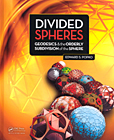- About MAA
- Membership
- MAA Publications
- Periodicals
- Blogs
- MAA Book Series
- MAA Press (an imprint of the AMS)
- MAA Notes
- MAA Reviews
- Mathematical Communication
- Information for Libraries
- Author Resources
- Advertise with MAA
- Meetings
- Competitions
- Programs
- Communities
- MAA Sections
- SIGMAA
- MAA Connect
- Students
- MAA Awards
- Awards Booklets
- Writing Awards
- Teaching Awards
- Service Awards
- Research Awards
- Lecture Awards
- Putnam Competition Individual and Team Winners
- D. E. Shaw Group AMC 8 Awards & Certificates
- Maryam Mirzakhani AMC 10 A Awards & Certificates
- Two Sigma AMC 10 B Awards & Certificates
- Jane Street AMC 12 A Awards & Certificates
- Akamai AMC 12 B Awards & Certificates
- High School Teachers
- News
You are here
Divided Spheres: Geodesics and the Orderly Subdivision of the Sphere

Publisher:
Chapman & Hall/CRC
Publication Date:
2012
Number of Pages:
509
Format:
Hardcover
Price:
69.95
ISBN:
9781466504295
Category:
Monograph
[Reviewed by , on ]
Charles Ashbacher
12/28/2012
The sphere is a simple structure, being completely symmetric about a point. It is naturally created by the actions of the laws of physics on pliable matter. This is often due to the fundamental property that spheres have the smallest surface area of all objects with a given volume. Spheres are also used in many areas, from sports to construction. However, it is the ways in which spheres are modified that make them functional and more interesting and that is the main point of the book.
A geodesic dome is of course a half-sphere and there must be some sturdy supporting lattice if the structure is to remain standing. Creating the strongest supporting structure using the minimum amount of materials is a max-min problem with solutions that are demonstrated in many ways. Solutions to real world problems using a modified sphere, from a neutrino sensor to the structure of pollen, are given and explained. Implementations of tessellated spheres are used to describe real-world situations, from computer processor grids to fish farming to the surface of golf balls to global climate models. This is a very entertaining section, demonstrating once again how powerful and useful mathematics is.
There are many ways to subdivide a sphere. Chapter 7 “Golf Ball Dimples”, shows a “critical” application of sphere modification. By game rule, a golf ball must be symmetric. The organization of the dimples stabilizes the flight and can significantly alter the air resistance, changing the distance the ball will travel. To the dedicated golfer, a ball that will travel even a yard farther is a jewel to be prized.
Given the simple mathematical definition and structure of the sphere, it would seem to be an object that is not interesting. However, the proper or improper alterations of the shape can make a dramatic difference and this book is an existence proof of how complex, interesting and useful properly altered spheres can be.
Charles Ashbacher splits his time between consulting with industry in projects involving math and computers, teaching college classes and co-editing The Journal of Recreational Mathematics. In his spare time, he reads about these things and helps his daughter in her lawn care business.
Divided Spheres. Bucky’s Dome. Putting Spheres to Work. Circular Reasoning. Distributing Points. Polyhedral Frameworks. Golf Ball Dimples. Subdivision Schemas. Comparing Results. Computer-Aided Design (CAD). Advanced CAD Techniques. Appendices. Bibliography. Index.
- Log in to post comments




